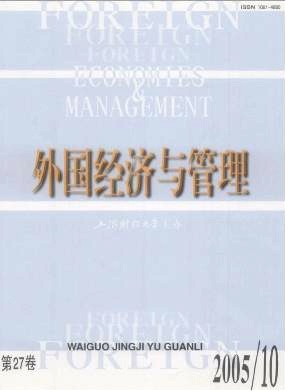知识经济时代的超现代管理范式评析
外国经济与管理 2005 年 第 27 卷第 10 期, 页码:
摘要
参考文献
摘要
本文认为,对西方超现代管理范式应做具体分析,它们以不同方式探究或表现当代西方企业组织与管理的特征,并揭示了西方现代管理学、现代管理范式的内在矛盾与种种消极后果,这对我们是有认识价值与借鉴意义的。
[1]Warren Weaver. Science and complexity [J], American Science. 1948, 36 (4):536-544.
[2] Frederick W Taylor. The principles of scientifie management [M]. New York:Harper & Row Publishing House, 1911.
[3] Floyd W Matson. The Broken image: man, science and society [M]. New York: George Braziller, 1964: 29.
[4] Pierre-Simon de Laplace. A philosophical essay on probabilities[A]. In: Sources in the history of mathematies and physical science [C]. Dover: Dover Publications ING (Original Work Published, 1795), 1951: 1-19.
[5] David Harvey. The condition of postmodernity: an enquiry into the origins of cultural change [M]. Cambridge, Massa chusetts: Basil Blackwell, 1989: 27.
[6] Harold Koontz. The management theory of jungle revised [J]. Academy of Management Journal, 1980, 5(2):175-187.
[7]芮明杰主编.管理学——现代的观点[M].上海:上海人民出版社,1999:1.
[8] William E Doll, Jr. A post-modern perspective on curriculum [M], New York:Teachers College Press, 1993:2.
[9] James P Crutchfield, J Doyne Farmer, Norman H Packard, and Robert S Shaw.Chaos[J]. Scientifi(?) American, 1986, 255(6):38-49.
[10] Tom J Peters & Robert H Waterman, Jr. In search of excellence: lessons from America's best run companies [M]. New York: Harper & Row, 1982.
[11] Tom J Peters. Thriving on chaos: handbook for management revolutions [M]. New York:Alfred P. Knopf, 1988.
[12] Tom J Peters. Liberation management:necessary disorganization for the nanosecond nineties [M]. New York:Alfred P. Knopf, 1992.
[13] Charles Handy. The age of unreason [M]. London: Century Hutchinson, 1989.
[14] Charles Handy. The empty raincoat: making sense of the future [M]. London:Century Press, 1995.
[15]罗珉.管理学范式理论的发展[M].成都:西南财经大学出版社,2005.
[16] Tom J Peters. Tom Peters's true confessions, on the 20th anniversary of "In Search of Excellence" [J]. Fast Company, 2001, 53(12): 78-81.
[17] Tom J Peters. Re-imagine: business excellence in a disruptive age [M]. London: Dorling Kindersley, 2003.
[18]罗珉.管理学范式理论研究[M].成都:四川人民出版社,2003.
[19] Stan Davis and Christopher Meyer. Blur: the speed of change in the connected economy [M]. Reading, Massachusetts: Addison-Wesley Year Published, 1997.
[20] Michael C Jackson. Beyond the fads: systems thinking for managers [J]. System Research, 1995, 12 (1): 25-42.
[21] Henry Mintzberg. Managing Quietly [J]. Leader to Leader, 1999, (12): 24-30.
[22] Henry Mintzberg. The rise and fall of strategic planning:reeonceiving roles for planning, plans, planners [M]. Englewood Cliffs, New Jersey: Prentice Hall International, 1994.
[2] Frederick W Taylor. The principles of scientifie management [M]. New York:Harper & Row Publishing House, 1911.
[3] Floyd W Matson. The Broken image: man, science and society [M]. New York: George Braziller, 1964: 29.
[4] Pierre-Simon de Laplace. A philosophical essay on probabilities[A]. In: Sources in the history of mathematies and physical science [C]. Dover: Dover Publications ING (Original Work Published, 1795), 1951: 1-19.
[5] David Harvey. The condition of postmodernity: an enquiry into the origins of cultural change [M]. Cambridge, Massa chusetts: Basil Blackwell, 1989: 27.
[6] Harold Koontz. The management theory of jungle revised [J]. Academy of Management Journal, 1980, 5(2):175-187.
[7]芮明杰主编.管理学——现代的观点[M].上海:上海人民出版社,1999:1.
[8] William E Doll, Jr. A post-modern perspective on curriculum [M], New York:Teachers College Press, 1993:2.
[9] James P Crutchfield, J Doyne Farmer, Norman H Packard, and Robert S Shaw.Chaos[J]. Scientifi(?) American, 1986, 255(6):38-49.
[10] Tom J Peters & Robert H Waterman, Jr. In search of excellence: lessons from America's best run companies [M]. New York: Harper & Row, 1982.
[11] Tom J Peters. Thriving on chaos: handbook for management revolutions [M]. New York:Alfred P. Knopf, 1988.
[12] Tom J Peters. Liberation management:necessary disorganization for the nanosecond nineties [M]. New York:Alfred P. Knopf, 1992.
[13] Charles Handy. The age of unreason [M]. London: Century Hutchinson, 1989.
[14] Charles Handy. The empty raincoat: making sense of the future [M]. London:Century Press, 1995.
[15]罗珉.管理学范式理论的发展[M].成都:西南财经大学出版社,2005.
[16] Tom J Peters. Tom Peters's true confessions, on the 20th anniversary of "In Search of Excellence" [J]. Fast Company, 2001, 53(12): 78-81.
[17] Tom J Peters. Re-imagine: business excellence in a disruptive age [M]. London: Dorling Kindersley, 2003.
[18]罗珉.管理学范式理论研究[M].成都:四川人民出版社,2003.
[19] Stan Davis and Christopher Meyer. Blur: the speed of change in the connected economy [M]. Reading, Massachusetts: Addison-Wesley Year Published, 1997.
[20] Michael C Jackson. Beyond the fads: systems thinking for managers [J]. System Research, 1995, 12 (1): 25-42.
[21] Henry Mintzberg. Managing Quietly [J]. Leader to Leader, 1999, (12): 24-30.
[22] Henry Mintzberg. The rise and fall of strategic planning:reeonceiving roles for planning, plans, planners [M]. Englewood Cliffs, New Jersey: Prentice Hall International, 1994.
引用本文
罗珉. 知识经济时代的超现代管理范式评析[J]. 外国经济与管理, 2005, 27(10): 0.
导出参考文献,格式为:
上一篇:《外国经济与管理》投稿须知





 5651
5651  0
0

